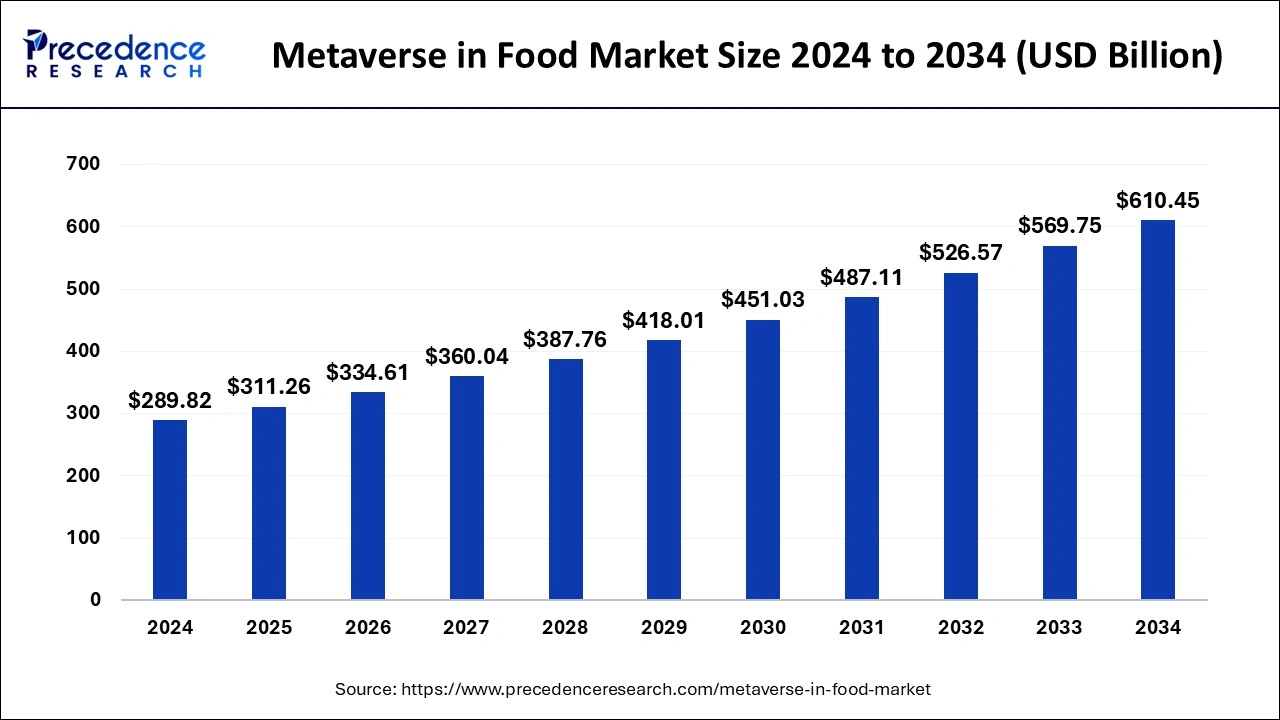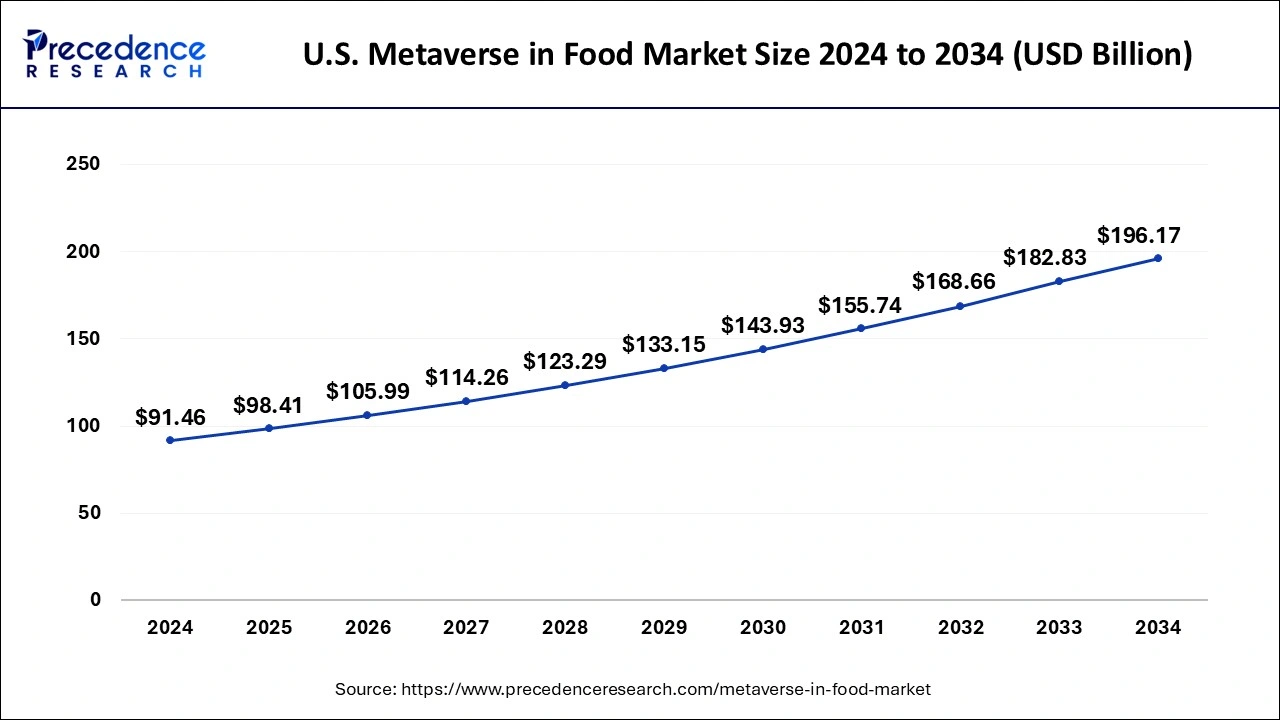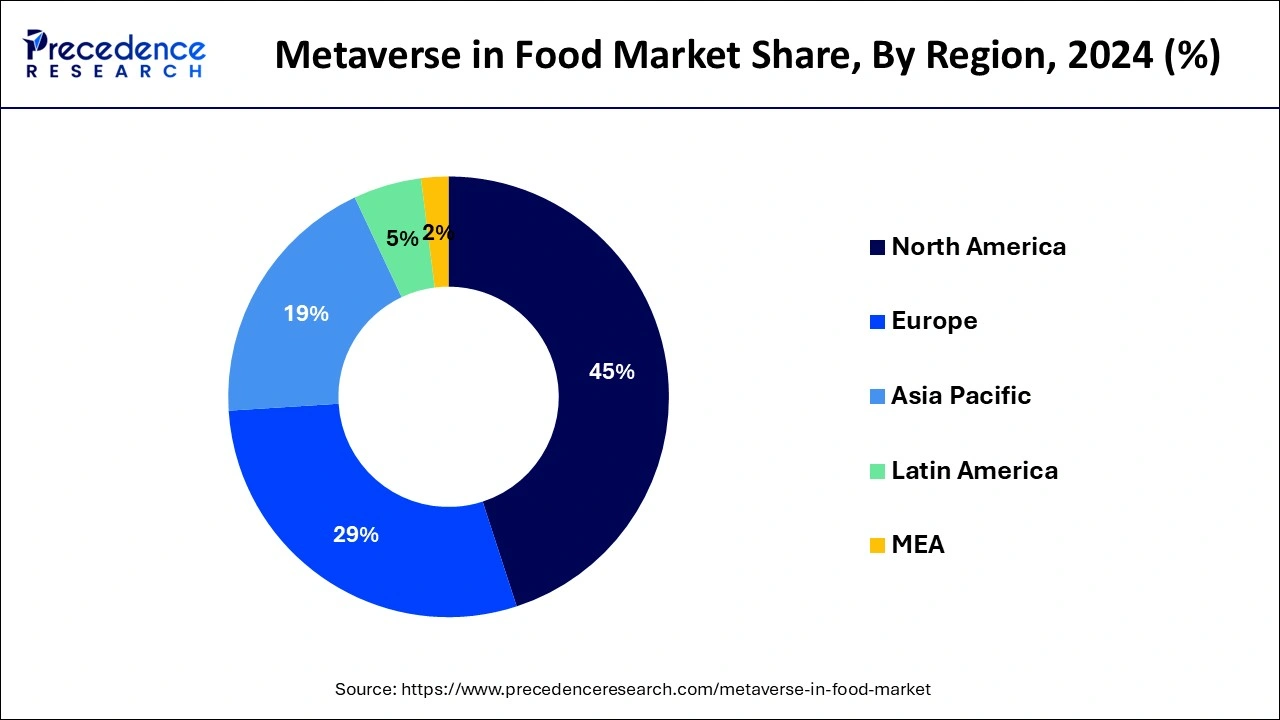Metaverse in Food Market Size and Forecast 2025 to 2034
The global metaverse in food market size accounted for USD 289.82 billion in 2024 and is predicted to increase from USD 311.26 billion in 2025 to approximately USD 610.45 billion by 2034, expanding at a CAGR of 7.73% from 2025 to 2034.

Metaverse in Food Market Key Takeaways
- The global metaverse in food market was valued at USD 289.82 billion in 2024.
- It is projected to reach USD 610.45 billion by 2034.
- The metaverse in food market is expected to grow at a CAGR of 7.73% from 2025 to 2034.
- North America contributed more than 45% of market share in 2024.
- Asia-Pacific is estimated to expand the fastest CAGR between 2025 and 2034.
- By consumer, the experience-driven foodies segment has held the largest market share of 33% in 2024.
- By consumer, the tech-savvy early adopters segment is anticipated to grow at a remarkable CAGR of 8.12% between 2025 and 2034.
- By food type, the exotic and culturally diverse cuisines segment generated over 35% of revenue share in 2024.
- By food type, the personalized dietary needs segment is expected to expand at the fastest CAGR over the projected period.
U.S.Metaverse in Food Market Size and Growth 2025 to 2034
The U.S. metaverse in food market size was exhibited at USD 91.46 billion in 2024 and is projected to be worth around USD 196.17 billion by 2034, growing at a CAGR of 7.93% from 2025 to 2034.

In 2024, North America holds a share of 45% in the metaverse in food market due to its robust technological infrastructure, widespread digital adoption, and a high level of consumer engagement. The region's well-established tech industry facilitates the seamless integration of virtual experiences, while a tech-savvy population embraces innovative digital platforms. Additionally, a strong food culture and a thriving market for culinary exploration contribute to the significant share. The convergence of advanced technology, cultural openness, and a digitally engaged populace positions North America as a key leader in shaping the metaverse in the food market.

The metaverse in the food market is poised for rapid expansion in Asia-Pacific due to a convergence of factors. The region's tech-savvy population, increasing internet penetration, and growing appetite for digital experiences contribute to the market's potential. Additionally, a vibrant food culture and a rising middle class amplify the appeal of virtual dining and culinary exploration. As businesses and consumers embrace digital innovation, the Asia-Pacific metaverse in the food market stands at the forefront of a transformative shift, promising significant growth and widespread adoption.
Meanwhile, Europe is witnessing significant growth in the metaverse in the food market due to a confluence of factors. Increased technological infrastructure, rising digital literacy, and a tech-savvy population contribute to the region's embrace of virtual experiences. The diverse culinary culture in Europe aligns well with the creative opportunities offered by the metaverse, attracting both businesses and consumers. Additionally, supportive government initiatives and a robust online ecosystem foster innovation, propelling the metaverse in the food market to thrive and gain prominence across the European continent.
Market Overview
The metaverse in the food industry refers to a digital realm where virtual and augmented reality technologies converge to create immersive culinary experiences. In this virtual space, users can engage in a variety of food-related activities, from exploring virtual restaurants and attending digital food festivals to participating in cooking classes with virtual chefs. It opens up opportunities for virtual dining, online culinary education, and gamified food experiences. Additionally, brands can establish a metaverse presence for marketing and engagement, while supply chains and nutritional education can be visualized in innovative ways. The metaverse in food embodies a fusion of technology and gastronomy, offering users novel and interactive ways to explore, experience, and engage with the culinary world beyond physical boundaries.
Metaverse in Food Market Data and Statistics
- In February 2022, Decentraland, a metaverse running on the Ethereum Blockchain, successfully raised $1.2 million through an auction and token marketplace. Additionally, Price Waterhouse Cooper Hong Kong invested $10,000 in LAND, a virtual real estate asset, within the Sandbox metaverse.
- A CNBC survey revealed that one in ten individuals engages in cryptocurrency investments, commonly used for trading various assets, including non-fungible tokens (NFTs).
- According to data from the 2022 SonicWall Cyber Threat Report, the first half of 2022 witnessed a surge in malware attacks, reaching 2.8 billion, marking an 11% increase compared to the previous year.
- Growth Factors
- Growing consumer interest in immersive virtual experiences, including virtual dining, where users can explore diverse cuisines and dining environments within the metaverse.
- Increasing demand for online culinary education and interactive cooking classes within the metaverse, providing users with the opportunity to learn and enhance their cooking skills in a virtual environment.
- The potential for food brands to leverage the metaverse for innovative marketing campaigns, brand engagement, and creating unique virtual experiences that resonate with consumers.
- The use of blockchain technology and non-fungible tokens (NFTs) to enhance transparency in the food supply chain, allowing users to trace the origin of virtual and real-world food products within the metaverse.
- Incorporating gamification elements into virtual food experiences, such as food-related challenges, quests, and rewards, to make the metaverse more entertaining and engaging for users.
- The growing acceptance and use of cryptocurrencies in metaverse transactions, including virtual food purchases, leading to a seamless and decentralized virtual economy within the food market.
Market Scope
| Report Coverage | Details |
| Growth Rate from 2025 to 2034 | CAGR of 7.73% |
| Market Size in 2025 | USD 311.26 Billion |
| Market Size by 2034 | USD 610.45 Billion |
| Base Year | 2024 |
| Forecast Period | 2025 to 2034 |
| Segments Covered | Consumer and Food Type |
| Regions Covered | North America, Europe, Asia-Pacific, Latin America, and Middle East & Africa |
Market Dynamics
Driver
Brand partnerships and marketing success
- In Sandbox, Price Waterhouse Cooper Hong Kong invested $10,000 in virtual real estate (LAND), demonstrating the willingness of traditional businesses to participate in metaverse ecosystems.
The growing collaboration between brands and successful marketing strategies is significantly boosting the demand for the metaverse in the food market. As brands increasingly recognize the potential of the metaverse, partnerships are formed to create immersive experiences for consumers. Marketing success in this virtual space has become a catalyst for market growth, as it captivates audiences and enhances brand engagement. This surge in demand is not only driven by technological advancements but also by the effective synergy between brands and metaverse platforms.
Furthermore, the metaverse in the food industry is gaining traction as marketing efforts focus on creating interactive and memorable experiences. Brands leverage the virtual world to showcase products, offer unique promotions, and build a strong online presence. The combination of brand partnerships and successful marketing endeavors is propelling the Metaverse in the food market, shaping it into a dynamic and thriving space for both businesses and consumers.
Restraint
Technological barriers
The growth of the metaverse in the food market encounters challenges primarily rooted in technological barriers, impeding widespread adoption. Many smaller food businesses face hurdles in integrating the metaverse due to a lack of access to advanced technologies and expertise. The demanding nature of metaverse implementation requires businesses to invest in cutting-edge tools, which can strain resources and limit the participation of smaller players in the market.
Moreover, the complexity of incorporating the metaverse into existing food systems poses a learning curve for businesses. Training staff and adapting to new technologies may be resource-intensive, further hindering seamless integration. Consequently, these technological barriers act as restraints on the market demand for the metaverse in the food industry, emphasizing the need for accessible solutions and supportive frameworks to ensure broader participation and successful implementation.
Opportunity
Personalized food experiences
The arrival of personalized food experiences within the metaverse is a game-changer, creating remarkable opportunities in the food market. By leveraging advanced technologies, businesses can tailor virtual culinary adventures to individual preferences. Virtual menus and interactive platforms allow users to customize their food experiences, from choosing ingredients to exploring unique flavor combinations, enhancing customer engagement and satisfaction.
Furthermore, the ability to cater to specific dietary needs and preferences within the metaverse offers a level of personalization that transcends traditional dining experiences. Businesses can seize this opportunity to not only meet individualized consumer demands but also to gather valuable data on user preferences, enabling targeted marketing strategies. The integration of personalized food experiences in the metaverse is reshaping the market landscape, presenting a compelling avenue for food businesses to connect with consumers on a more intimate and customized level.
Consumer Insights
The experience-driven foodies segment held the highest market share of 33% in 2024. In the metaverse in food market, the experience-driven foodies segment refers to consumers seeking immersive and engaging culinary adventures. These individuals prioritize interactive virtual dining experiences, personalized menus, and unique flavor explorations. The trend involves a growing demand for virtual tastings, interactive cooking classes, and dynamic collaborations with chefs and brands. As technology advances, the metaverse caters to the preferences of experience-driven foodies, offering a novel platform for customized and enjoyable food encounters, redefining how consumers engage with and savor their culinary experiences.
The tech-savvy early adopters segment is anticipated to witness rapid growth at a significant CAGR of 8.12% during the projected period. Tech-savvy early adopters in the metaverse in food market represent consumers who eagerly embrace new technologies. This segment seeks immersive culinary experiences, navigating virtual platforms to discover and engage with innovative food offerings. Trends indicate a preference for personalized virtual menus, interactive cooking simulations, and social dining experiences. As pioneers in metaverse interactions, these consumers influence the market by fostering demand for cutting-edge virtual food events and collaborations, shaping the future landscape of digital gastronomy.
Food Type Insights
The exotic and culturally diverse cuisines segment has held a 35% market share in 2024. In the metaverse in food market, the segment defined by exotic and culturally diverse cuisines is gaining significant attention. This category encompasses virtual spaces dedicated to exploring and experiencing unique global flavors. Users can engage in immersive culinary journeys, sampling dishes from various cultures within the digital realm. This trend reflects a growing demand for diverse and exotic food encounters, allowing users to virtually travel the world through their taste buds, fostering cultural appreciation and expanding the possibilities of gastronomic exploration in the metaverse.
The personalized dietary needs segment is anticipated to grow rapidly over the projected period. In the metaverse in the food market, the personalized dietary needs segment caters to individual nutritional preferences. This innovative approach allows users to tailor virtual dining experiences based on specific dietary requirements such as vegetarian, vegan, gluten-free, or other health considerations. Recent trends show a surge in demand for personalized dietary options within the metaverse, reflecting a growing awareness and prioritization of individualized nutrition. This segment not only enhances user satisfaction but also aligns with the broader trend of health-conscious consumer choices in the digital dining landscape.
Recent Developments
- In February 2022, Electronic Arts launched GRID Legends, enhancing seamless gameplay, coordinating multiplayer sessions, and fostering collaborative storytelling among racers. Users can effortlessly discover live events matching their preferences, join real-time events, design races with the Race Creator, or set up private lobbies for personalized group experiences.
- In January 2022, Microsoft revealed its acquisition of Activision Blizzard, Inc., anticipating a boost in metaverse industry development and accelerated growth in Microsoft's gaming business across mobile, PC, cloud, and console platforms.
- In September 2022, Wolters Kluwer introduced two cutting-edge blockchain-based metaverse technologies, Somnium Space and Decentraland. These advanced platforms enable showcasing residential properties, gaming assets, and more, elevating sales growth for clients.
- In January 2022, Space Falcon, a blockchain-based gaming enterprise, secured a $4 million investment to revolutionize traditional gaming through blockchain technology. The company aims to create a metaverse environment using premium NFTs and blockchain, pushing the boundaries of gaming experiences.
Metaverse in Food Market Companies
- Meta (formerly Facebook)
- Microsoft
- Unity Technologies
- NVIDIA
- Epic Games
- Roblox Corporation
- Spatialand
- Somnium Space
- Decentraland
- Samsung
- HTC Corporation
- Alibaba Group
- Sony Corporation
- Apple Inc.
Segments Covered in the Report
By Consumer
- Tech-savvy Early Adopters
- Experience-driven Foodies
- Health-conscious Consumers
- Sustainability-focused Consumers
By Food Type
- Luxury and Gourmet Foods
- Personalized Dietary Needs
- Exotic and Culturally Diverse Cuisines
- Experimental and Virtual-only Creations
By Geography
- North America
- Europe
- Asia-Pacific
- Latin America
- Middle East and Africa
For inquiries regarding discounts, bulk purchases, or customization requests, please contact us at sales@precedenceresearch.com
Frequently Asked Questions
Ask For Sample
No cookie-cutter, only authentic analysis – take the 1st step to become a Precedence Research client
 sales@precedenceresearch.com
sales@precedenceresearch.com
 +1 804-441-9344
+1 804-441-9344